
|
February 13th 2008
A Franco-American Love Story
By Philippe Defechereux © 2008
This is the tale of a long love affair spanning two generations and reaching across the Atlantic Ocean. The object of love is a little French racer (photo below) made by Deutsch-Bonnet, a manufacturer of highly successful small-bore racing cars that reigned supreme in their class between 1952 and 1962 from Le Mans to Sebring, FL.
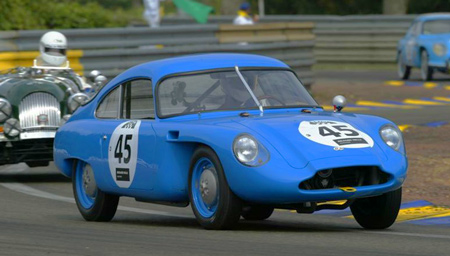
Deutsch-Bonnet HBR5, chassis #1057 at the Le Mans Vintage 24 Hours event in 2002. Powerplant is race-tuned Panhard flat twin 850cc engine.
Skip Cook at the wheel. Photo © J-E Descombes (www.sportmeca.com)
|
The story of this romance, like a best-selling novel, is packed with great acts of daring, passion, unlikely coincidences, political treachery, strong friendships, financial issues, long-lost treasures re-discovered and a “coming full-circle” happy ending. Yet, it is very real. The key suitors are a father-and-son pair from New York; the main supporting cast is composed of Alec Ulmann, founder of the Sebring Twelve-Hour race; Charles Deutsch and René Bonnet, French entrepreneurs, designers, businessmen and racing drivers. Other members of the cast include several American racing drivers and enthusiasts, a renowned journalist and ace restorers of badly weathered vintage cars. The locales for the story are Le Mans, south of Paris; New York City, Sebring in central Florida and Los Angeles, California. Fasten your five-point seatbelt.
Part I
The Birth of Deutsch-Bonnet
Charles Deutsch was a trained body designer born in 1911. In the mid-1920’s he owned a body shop in Champigny-sur-Marne, close to Paris. In 1932, René Bonnet, also an entrepreneur and car enthusiast, was given the opportunity to buy the business, which he did. Deutsch then was getting his engineering degree, with a focus on aerodynamic science. By 1935, the two had become partners and started building and racing cars powered by Citroën engines — René Bonnet owned a Citroën dealership that helped finance the racing operations.
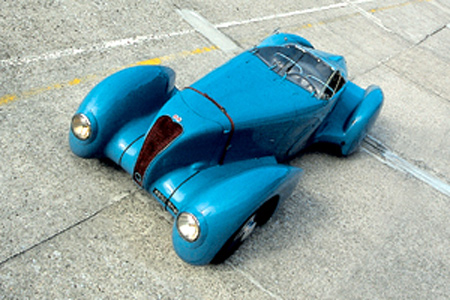
The second Deutsch-Bonnet, the DB2, built just before WWII, was powered by a 1.5 litre Citroën engine. The current Swiss owner had it beautifully restored.
|
They met with mixed success, then World War II interrupted their activities. These
were quickly resumed after the war and by October, 1949, the Deutsch-Bonnet Company was showcasing a GT coupe powered by a Citroën two-litre engine at the Paris Salon de l’Automobile. Deutsch had designed and built the body and adapted the suspension while Bonnet fit the engine and other mechanical components to it and took care of final assembly. They were hoping to start a small production run.
Though the car drew a lot of attention at the Salon, Citroën quickly nixed any hope of officially supplying engines even for a small production run, citing “company policy” not to supply components to outsiders who could compromise the marque’s reputation. One may surmise that Pierre Bercot, the autocratic head of Citroën, felt a bit threatened by those two aggressive racing enthusiasts and their dream of a production line. A new suitor was needed, in the form of an appropriate engine-maker.
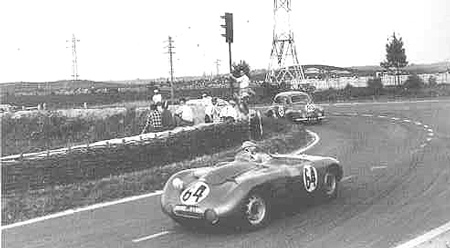
Citroën-engined D.B. at LeMans in 1950, driven by Simone/Aunaud it retired with bearing failure. 611cc D.B. Panhards finished 23rd, 28th and 29th, a sign of things to come. Photo credit: Serge Pozzoli collection.
|
René and Charles turned to Panhard, a most respected French car company founded in 1891 at the dawn of the automobile era. René Panhard and Emile Levassor, the original founders, are actually credited with inventing the design of the modern automobile layout: front-engine mated to a gearbox; then transmission of power to the rear wheels through a transversal axle. The year was 1892. Panhard-Levassor also proved innovative in suspension design, including the rear axle-straightening “Panhard rod,” still in use today by a few manufacturers. Levassor died in 1897 and the name of the company was changed to just Panhard in 1915.
By 1946, having been considerably diminished by the great depression, then World War II, the company had been downsized severely and was only capable of designing a single small model: the Dyna Panhard. Though its body had definite pre-war looks, the car was revolutionary in many ways. its body was made of aluminum, and so was its two-cylinder air-cooled engine, displacing a mere 610 cc. The crankshaft, though, had roller-bearings, which allowed the engine to rev significantly higher than its rivals. Power was transmitted to the front wheels through a four-speed gearbox. The chassis featured an independent front suspension while the rear suspension had a v-shaped axle and six torsion bars.
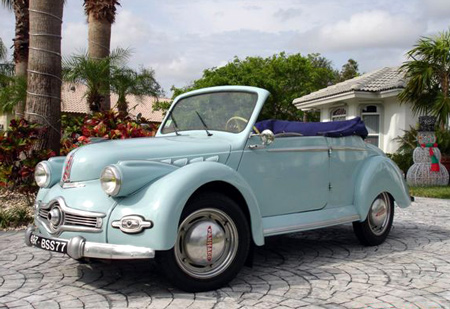
1950 Dyna Panhard X-85 "décapotable," property of René Hodot. Designed by Jean-Albert Grégoire,(althought modified for production) the Panhard was one of the most advanced cars in the post war era. Courtesy Pierre Hudot, Florida.
|
To quote the U.S. fan club for Panhards: “It was a miracle of lightweight, advanced engineering.” That technology is just what Deutsch-Bonnet needed.
A deal and a plan were quickly hatched: Panhard would supply engines and suspension components to Deutsch-Bonnet; these would then be mated with the Charles Deutsch-designed bodies in the Champigny garage under René Bonnet’s managerial and financial supervision. Deutsch-Bonnet, the company, was back in business, with a new mission but also an extensive experience pool going back thirty years. Even though the maverick French company would end up producing fewer than one thousand cars, they would make their mark on the racing scene on both sides of the Atlantic and help create a seminal racing event in America that is still famous in our 21st century.
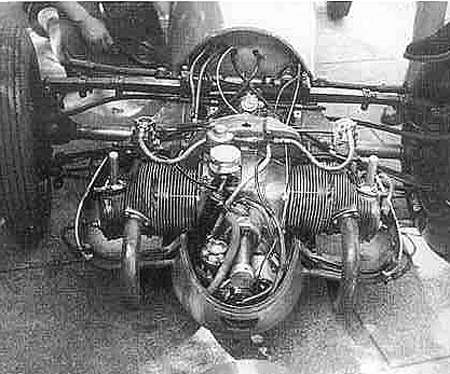
Panhard engine in a D.B. "Monoplace" in 1950. Air cooled and very light, it was hung foward of the front axles and was front wheel drive. Photo credit: Serge Pozzoli Collecton.
|
In order to achieve that feat, they proved themselves on the racetrack early on, and not surprisingly so. After all, Deutsch-Bonnet sold sporty GT coupes to the enthusiast. Racing and winning was the obvious best form of publicity for the marque. In addition, both founders were pretty talented drivers themselves. Given the small displacement of their engine, they would compete for victory in the “Index of Performance” category in famous endurance races.
This unique category was a creation of the French racing authorities meant to allow small-bore automobiles to garner a share of the laurels if they exceeded their expected performance standards (based on engine displacement, etc.) by the widest margin.
Overall victory for the small-bore racecars was not an option against the powerful Ferraris, Jaguars, Aston Martins and Mercedes-Benz of the early 1950s. This was especially true in France when the French government, made up of socialists and communists, imposed heavy taxes on high-horsepower cars, slowly starving the glorious pre-war Delage, Talbot and Bugatti builders. French racing organizers, though, richly rewarded Index of Performance winners.
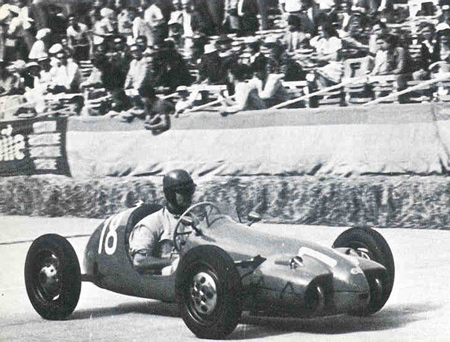
The D.B. "Monoplace" was raced in French Formula III events and often had classes of their own. The Marquis de Portago started his racing career in one. Serge Pozzoli.
|
The first competitive “D.B. Panhard” racer was a sleek sports car powered by a 610 cc flat-twin engine and a Panhard rear suspension tweaked by Charles Deutsch. It won it’s class and Index of Performance at the 12-hour Grand Prix of Paris at Montlhéry in 1950. Charles Deutsch had studied aerodynamic science in earnest since the mid-1930’s; this was a breakthrough advantage for small bore cars when the rest of the field was still mainly into a horsepower race, ignoring the great handicap of air resistance. In 1951, Deutsch-Bonnet fielded two cars for the Le Mans 24-hour race. With their engine upgraded to 850 cc, they only finished fifth on the index of performance, but both cars did complete the race (Bonnet-Bayol were 21st overall, while Arnaud-Pons were 30th). This highly impressed a wealthy and passionate American racing fan by the name of Alec Ulmann, a man with big dreams about bringing European-style racing to America.
Sebring-- The Daring Leap of Faith
Alexander Edward Ulmann (‘Alec’) was born in St. Petersburg, Russia, in 1903. His father was a wealthy industrialist; his mother was from the de Volgensky family, of minor nobility. Following the Soviet revolution of 1917, the family fled to Switzerland from which Alec Ulmann sailed to America to attend MIT. By then, besides his native Russian, his was fluent in English, French and German. At MIT, he acquired both a master’s degree in aeronautical engineering and a taste for powerful American cars. After graduating, he worked for Goodyear, then Lockheed.
He also nurtured an intense interest for European-type car racing, a passion shared by of a small group of wealthy East Coast enthusiasts who had created the Automobile Racing Club of America (ARCA). Among the members were the Collier Brothers, Briggs Cunningham, George Rand, Charles Moran and George
Weaver.
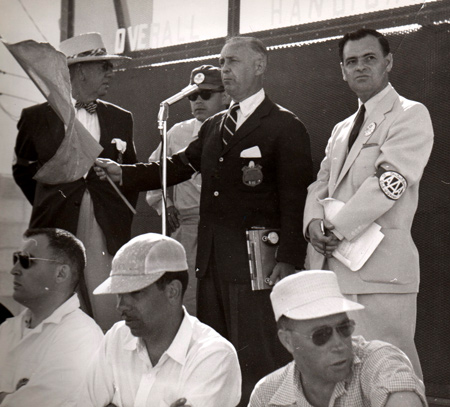
Alec Ulmann (center) at Sebring in 1950. The AAA official to his left is Jim Clemenger of the AAA contest board. Courtesy Edward Ulmann
|
Alec Ulmann attended the Le Mans 24 Hours a few times during those years, and a seed was planted in his mind, but the onset of World War II put everything on hold. Alec Ulmann made his own fortune building aircraft gear for the Air Force.
As the War was coming to an end, car racing quickly resurfaced as a main interest for the ARCA members; in 1944, they founded a new organization called the Sports Car Club of America (SCCA). The words “Sports Car” were key: Detroit did not build any; these were the small, agile European touring cars the G.I.s had discovered in Europe: M.G.s, Jaguars, Maseratis, and Alfa Romeos. Alec Ulmann became the Club’s first activities Chairman and quickly adapted the old ARCA rules to the post-war situation, also acting as Chief Steward for the earliest American road-racing events such as Watkins Glen, Bridgehampton, and the Palm Beach Shore races.
One of Alec Ulmann’s best pals was Hobart “Bill” Cook, a U.S. Navy admiral’s son, Grumman test pilot and racing enthusiast all-in-one. They shared a seemingly impossible dream: bringing long-distance endurance racing, exemplified by the Le Mans 24 Hours, to America, with the blessing of the international ruling body (Fédération Internationale de l’Automobile, or FIA) and the participation of the greatest European racing teams of the era: Ferrari, Aston-Martin, Jaguar, Talbot, Delage, among others. Says Edward Ulmann, son of Alec: “I remember going with my father to Bill Cook's estate -- I think it may have been in Westchester county. I was left to play with my football while the men discussed big plans.”
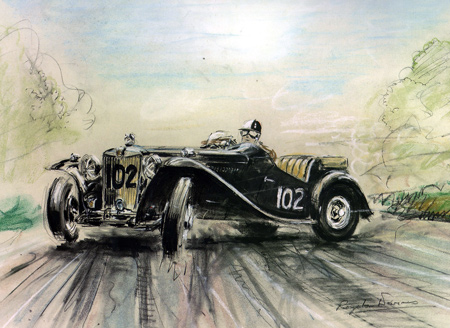
Painting of Hobart “Bill” Cook “in full recovery” at the wheel of his race-tuned M.G. TC at Watkins Glen in the 1950 Seneca Cup. Courtesy Arthur B. Cook.
|
At that time, Alec Ulmann owned Hendricks Field, a former training base for B-17 bomber crews, located near Sebring in central Florida, using it as a venue for his new business: converting or upgrading surplus WWII aircraft. Its many intersecting runways offered endless possibilities for tracing a racing course. Despite nearly intractable political conflicts between the SCCA, the FIA and the Automobile Association of America (AAA), which at the time was the only FIA-recognized body in North-America sanctioned for international car racing (the AAA then ran the Indianapolis 500), Alec Ulmann and his racing enthusiast compatriots managed to stage a successful six-hour endurance race at Sebring on December 30, 1950, with 28 participants. It was run on an Index of Performance classification basis.
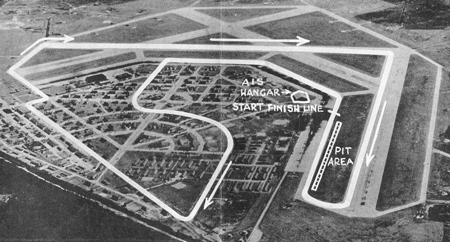
Hendricks Field, near Sebring, FL, and the final 5.2 mile course chosen by Alec Ulmann and his partners for the 1952 race and years thereafter, as published in Speed Age. The changes from 1950 were relatively minor.
|
There were several Ferraris, Aston Martins DB-2’s and Cadillac-powered Allards, but also small-bore Fiats, a Morris Minor and even a 724cc Crosley at the start, as “Index of Performance” was the only winning criteria for this event. At the end of six hours, the tiny Crosley, driven by Fritz Kostler and Ralph Deshon won the laurels! Jim Kimberly’s 166MM Ferrari barchetta placed second, while Robert T. Keller finished third in a 1,100cc Fiat coupe.
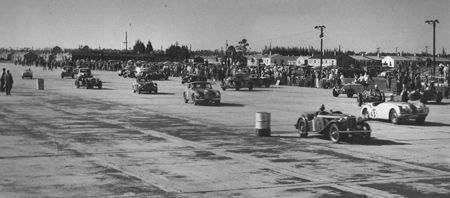
Sebring, FL, December 30, 1950 at 3;00 pm. The diversity of participating cars can be quickly grasped. In fact, the tiny little car in the back to the left is the Crosley that would eventually win the race. Photo courtesy Frank Campanale Collection.
|
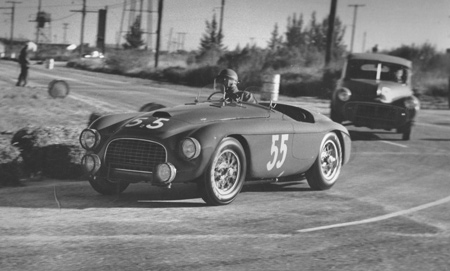
Several Ferraris competed at Sebring's first race in December, 1950. One was Number 55, the Jim Kimberly-Marshall Lewis 166MM which placed second. Photo courtesy Frank Campanale collection.
|
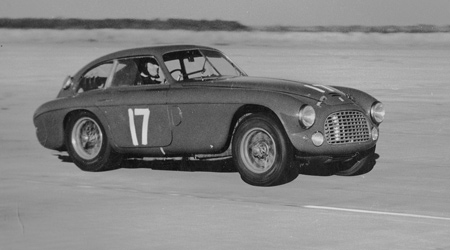
Sebring, FL, December 30, 1950 at 3:00 pm. Another Ferrari, a French Blue 195 S owned by Briggs Cunningham was driven by Luigi Chinetti and Alfred Momo. It placed 7th. Photo courtesy Frank Campanale collection.
|
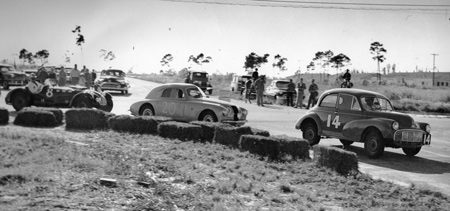
Sebring, FL, December 30, 1950. A Morris Minor of B.Thomas leads Robert T. Keller’s 1,100 cc Fiat that finish third, and Fred Wacker's Allard into a turn. The Morris finished 19th overall, the Allard in 8th. Photo courtesy Frank Campanale collection.
|
While in France in the summer of 1950 managing the Briggs Cunningham racing team at Le Mans, Alec Ulmann was able to lobby the various European racing authorities and obtain both FIA and AAA accreditation for the next Sebring endurance race, planned for 1952. European teams could now come and compete at Sebring. There were, however two major problems still to be solved. First, the SCCA did not recognize the FIA as having any authority on American racing and considered members who went by FIA doctrine as heretics. Second, the FIA, though it blessed the forthcoming Sebring endurance race, did not allocate winning participants any points for the international endurance championship, which made it hard for teams to justify the expense of shipping cars and drivers to America. The Alec Ulmann-Bill Cook pair would solve the two problems with both great moral stress and superb gamesmanship. There would be another pair of daring men in this high-stakes game: René Bonnet and Charles Deutsch.
The stress-ridden part was the one Alec Ulmann would have to play. The SCCA insisted that car racing in America was “for the membership only,” and that “this is not Europe and it is 1951, and the surest way to promote fair club competition is to use classifications to fit cars available now in the United States. Hence, the SCCA revised-classes make a good deal more sense than the international FIA-imposed ones.” This made any sanctioned international racing in America under the SCCA umbrella simply impossible. Said Alec Ulmann in his book “The Sebring Story:” “The dilemma confronting me was either to knuckle down to the dictates of the club’s management and forever forego an international racing future for Sebring, or to become a rebel and resign from the club, which I had helped create, and of which I was a Life Member.” He eventually resigned from the SCCA and the Ulmann-Cook pair set out to create the first FIA-approved endurance race in America: the Twelve Hours of Sebring.
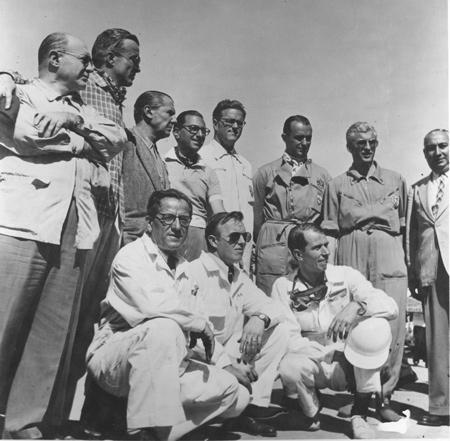
Members of the SCCA and Argentinean officials just before the March 17,1951 Sports Car Grand Prix of Argentina. Top from left to right: Tony Pompeo, Fred Wacker, John Perona, local official, Bill Spear, George Rand, Jim Kimberly, local official. Bottom: Alfred Momo, Jack Donaldson, John Fitch. This was part of the push by Alec Ulmann to “go international.” Juan and Evita Peron hosted the event. Courtesy Edward Ulmann.
|
Using his Le Mans experience and his fluency in French, Alec Ulmann had already established contacts with René Bonnet. Using this lead, Bill Cook agreed to “sponsor” a Deutsch-Bonnet team of two cars for the 1952 event, on condition that the team be entered as a factory team named “Automobiles Deutsch-Bonnet” and that René Bonnet drive one of the cars. In reality, Bill Cook had simply bought three cars from Deutsch-Bonnet; two barquettes and a coupe. He would finance most of the operation. This “arrangement” was quite common and accepted in those days for small cash-strapped racing factories. More important, it gave the Sebring event an international aura, with France at its center as the FIA is based in Paris; a French car team would be sure to benefit greatly.
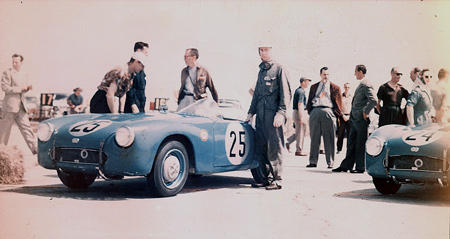
Rare color photo of the two Deutsch-Bonnet barquettes before the start of the first Sebring Twelve Hours. Hobart “Bill” Cook is the tall dark-haired man behind the gentleman with a white cap. Wade Morehouse is standing next to the driver’s door, ready to race. Courtesy of Wade Morehouse.
|
Next: Part II. The triumph of the Sebring Twelve Hours and the D.B. team, plus the first life of D.B. chassis 1057.
|

|



